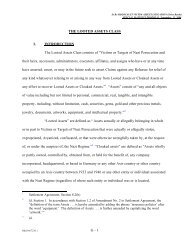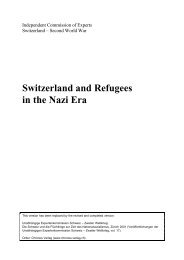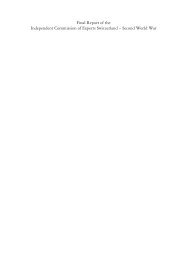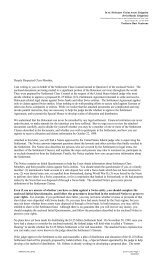Switzerland and Gold Transactions in the Second World War
Switzerland and Gold Transactions in the Second World War
Switzerland and Gold Transactions in the Second World War
Create successful ePaper yourself
Turn your PDF publications into a flip-book with our unique Google optimized e-Paper software.
Interim Report on <strong>Gold</strong> 40 Chapter 1<br />
Germany’s gold reserves began to fall <strong>in</strong> December of 1933, reach<strong>in</strong>g $28.6 million at <strong>the</strong> end of<br />
1937. 72 It changed little dur<strong>in</strong>g <strong>the</strong> war. 73<br />
I/2. Hidden Reserves. In 1933, Reichsbank President Schacht began a policy of secretly accumulat<strong>in</strong>g<br />
gold on several different accounts. 74 Widely believed by Reichsbank employees to be a warpreparation<br />
fund, <strong>the</strong>se hidden reserves were worth $82.7 million by September of 1939. 75<br />
I/3. O<strong>the</strong>r German Banks-of-issue. Several banks-of-issue, such as <strong>the</strong> Bavarian State Bank, were still<br />
exist<strong>in</strong>g <strong>in</strong> Germany from <strong>the</strong> time prior to unification. Toge<strong>the</strong>r <strong>the</strong> banks held $12.1 million <strong>in</strong><br />
gold which was placed at <strong>the</strong> disposal of <strong>the</strong> German government. 76<br />
I/4. Austrian <strong>Gold</strong> Reserves. After <strong>the</strong> «Anschluss» <strong>in</strong> 1938, <strong>the</strong> gold reserves of <strong>the</strong> National Bank of<br />
Austria, <strong>in</strong>ventoried at $99 million, were amalgamated with those of <strong>the</strong> Reichsbank <strong>and</strong><br />
transferred to Berl<strong>in</strong>. 77 Subsequently, Austrians became subject to German law requir<strong>in</strong>g citizens to<br />
turn <strong>the</strong>ir gold hold<strong>in</strong>gs over to <strong>the</strong> government. Private gold received before September of 1939 is<br />
<strong>in</strong>cluded <strong>in</strong> «Hidden Reserves»; subsequent receipts of gold are accounted for <strong>in</strong> <strong>the</strong> «Four-Year<br />
Plan Activities» described later. 78<br />
I/5. Czechoslovak <strong>Gold</strong> Reserves. Unlike <strong>the</strong> National Bank of Austria, <strong>the</strong> Czechoslovak central bank<br />
was never absorbed by <strong>the</strong> Reichsbank. Instead, it was newly organized as <strong>the</strong> National Bank of<br />
Bohemia <strong>and</strong> Moravia <strong>and</strong> its gold, though confiscated de facto by <strong>the</strong> German government, was<br />
transferred to separate accounts <strong>in</strong> <strong>the</strong> Reichsbank. Withdrawals from <strong>the</strong> accounts were always<br />
reimbursed <strong>in</strong> paper Reichsmarks. A part of Czechoslovak gold reserves was transferred to Bern,<br />
London, <strong>and</strong> New York before <strong>the</strong> <strong>in</strong>vasion, but was returned to German control through swaps<br />
with<strong>in</strong> <strong>the</strong> BIS. $34.3 million <strong>in</strong> Czechoslovak gold contributed to <strong>the</strong> German reserves. 79 The<br />
Czechoslovak reserves held <strong>in</strong> <strong>Switzerl<strong>and</strong></strong> were transferred to <strong>the</strong> account of <strong>the</strong> Reichsbank by<br />
telegraphic order on 7 March 1939, one week before <strong>the</strong> German <strong>in</strong>vasion. 80<br />
72<br />
73<br />
74<br />
75<br />
76<br />
77<br />
78<br />
79<br />
80<br />
For <strong>in</strong>stance, <strong>the</strong> Schweizerische Nationalbank 1939, p. 55 (Monthly Report January 1939). An exchange rate of 2.479<br />
RM/$ has been used for <strong>the</strong> Reichsmark (RM). United States Code of Federal Regulations 1940, Suppl. Title 31:<br />
Money <strong>and</strong> F<strong>in</strong>ance.<br />
«<strong>Gold</strong>best<strong>and</strong> am 1.9.1939» <strong>and</strong> «Sonderdevisene<strong>in</strong>gang zwischen dem 1.9.1939 und dem 1.11.44» [Memor<strong>and</strong>um,<br />
«<strong>Gold</strong> reserves on 1 September 1939» <strong>and</strong> «Special receipts of foreign exchange between 1 September 1939 <strong>and</strong> 1<br />
November 1944»], Four-Year Plan, 28 November 1944. Center for Historical Documents («Special Archives»),<br />
Moscow, Inventory 700-1-97. Fur<strong>the</strong>ron quoted as Four-Year Plan Documents.<br />
Conversion Account, 1933, <strong>and</strong> Special Purposes Account, 1934. These two accounts were closed <strong>in</strong> 1935; An account<br />
for gold purchases was opened <strong>in</strong> 1934 to which most of <strong>the</strong> gold from <strong>the</strong> Conversion <strong>and</strong> <strong>the</strong> Special Purpose Account<br />
was transferred. An Audit<strong>in</strong>g Account was opened <strong>in</strong> 1933, an account for Secret <strong>Gold</strong> <strong>in</strong> 1935, <strong>and</strong> a fifth account for<br />
Special Purposes («DER») <strong>in</strong> 1937. These hidden reserves were sometimes described by Reichsbank employees as <strong>the</strong><br />
new «Juliusturm», <strong>in</strong> reference to pre-<strong>World</strong> <strong>War</strong> I gold reserves hidden <strong>in</strong> case of war. US National Archives, RG 260,<br />
Box 444, Office of <strong>the</strong> F<strong>in</strong>ancial Division <strong>and</strong> <strong>the</strong> F<strong>in</strong>ance Advisor, File 940.62 Work Papers, Table I, «Balances of Six<br />
Hidden <strong>Gold</strong>-Reserve Accounts of <strong>the</strong> Reichsbank». Fur<strong>the</strong>ron quoted as Six Hidden <strong>Gold</strong>-Reserve Accounts.<br />
Four-Year Plan Documents.<br />
Four-Year Plan Documents.<br />
US National Archives. RG 43, M-88, Box 201, Memor<strong>and</strong>um from O. F. Fletcher, «Revised Estimate of German <strong>Gold</strong><br />
Movements from March 1938 to May 1945», 12 June 1946. Fur<strong>the</strong>ron quoted as Fletcher Memor<strong>and</strong>um.<br />
See I/2 <strong>and</strong> III/1 of <strong>the</strong> comments to Table I. The Austrian gold reserves were <strong>in</strong>corporated <strong>in</strong>to <strong>the</strong> general gold<br />
reserves of <strong>the</strong> Reichsbank. The possibility of a double assessment can be excluded. There was no large <strong>in</strong>crease <strong>in</strong> <strong>the</strong><br />
hidden reserves <strong>in</strong> 1938, <strong>in</strong>dicat<strong>in</strong>g that Austrian gold was at that po<strong>in</strong>t still recorded separately <strong>in</strong> <strong>the</strong> Reichsbank<br />
accounts. Six Hidden <strong>Gold</strong> Reserve Accounts.<br />
Four-Year Plan Documents.<br />
SNB Archives, <strong>the</strong> amount listed here <strong>in</strong>cludes only Czechoslovak gold which was taken over by <strong>the</strong> Germans after <strong>the</strong><br />
<strong>in</strong>vasion. The so-called shipment prior to <strong>the</strong> <strong>in</strong>vasion must be <strong>in</strong>cluded ei<strong>the</strong>r under I/2 (Hidden Reserves) or under<br />
III/1 (Four-Year Plan Activities).







